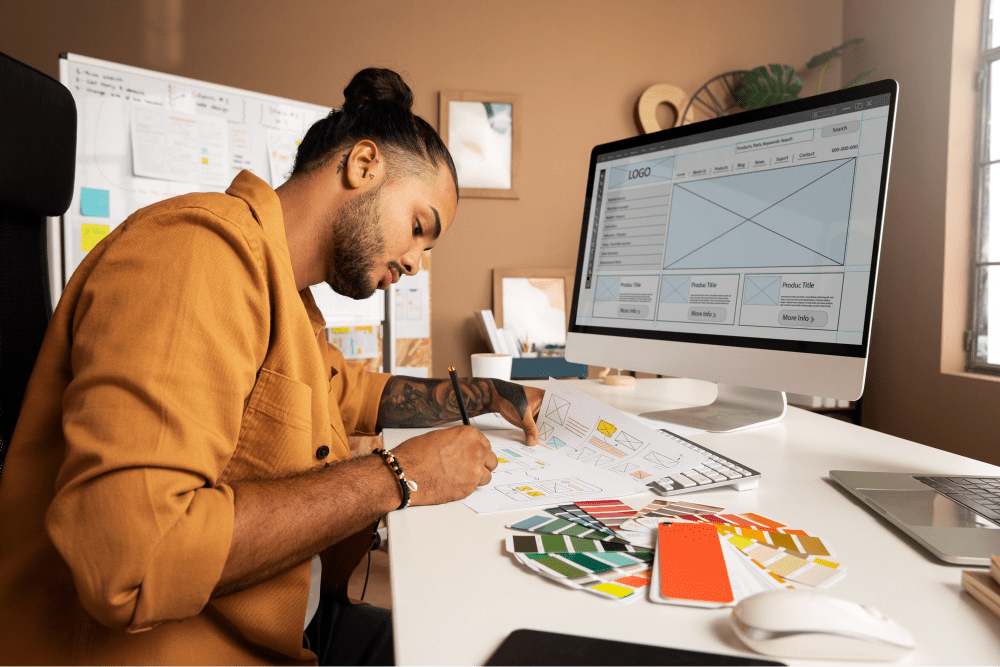Graphic Design to UI/UX Design
May 29, 2024

Switching from graphic design to UX design is a transformative journey that many creatives are making today. The shift involves not just a change in tools and techniques, but a fundamental shift in mindset. This guide will walk you through everything you need to know to successfully transition from a graphic designer to a UX designer, leveraging your existing skills while acquiring new ones.
Graphic Design: Focuses on aesthetics, visual storytelling, and brand identity. It’s about creating visually appealing designs that communicate a message effectively.
UX Design: Centers on the user’s experience and interaction with a product. It’s about solving problems and making products easy to use, enjoyable, and accessible.
While both disciplines value creativity and design principles, UX design requires a deeper understanding of user psychology, usability, and functionality.
As a graphic designer, you already have a strong foundation in design principles, creativity, and software proficiency. Here’s how to leverage those skills in UX design:
Your ability to create visually compelling designs will be invaluable in UX design, particularly in the UI (User Interface) aspect, which focuses on the look and feel of the product.
Programs like Adobe Photoshop, Illustrator, and Sketch are used in both fields. Familiarity with these tools gives you a head start, although you may need to learn additional software such as Figma, Adobe XD, or Axure for prototyping and wireframing.
Your creative approach to problem-solving is crucial in UX design. Here, creativity is used to enhance user experience and address user pain points effectively.
To transition to UX design, you’ll need to acquire new skills and knowledge. Here are key areas to focus on:
1. Understanding User Research
Learn how to conduct user research to understand user needs, behaviors, and motivations. This involves techniques like user interviews, surveys, and usability testing.
2. Wireframing and Prototyping
Wireframing is creating a blueprint of your design, while prototyping involves creating interactive models of your design. Tools like Figma, Adobe XD, and Axure are commonly used.
3. Information Architecture
Understand how to organize and structure content in a way that is intuitive and accessible to users. This involves creating sitemaps and user flows.
4. Usability and Accessibility
Learn the principles of usability and accessibility to ensure your designs are user-friendly and inclusive.
5. Interaction Design
Focus on how users interact with your design, including animations, transitions, and interactive elements.
6. Building a UX Portfolio
Transitioning to UX design requires showcasing your new skills. Here’s how to build a compelling portfolio:
7. Include UX Case Studies
Create case studies that demonstrate your process from user research to final design. Highlight the problem, your approach, the solution, and the outcome.
8. Redesign Existing Projects
Take some of your graphic design projects and reimagine them from a UX perspective. Show how you would improve the user experience.
9. Work on Real Projects
Gain experience by working on real projects, whether through freelance work, internships, or personal projects. Platforms like Upwork and Behance can help you find opportunities.
10. Get Feedback
Seek feedback from experienced UX designers and iterate on your designs. Use platforms like Dribbble, Behance, and UX design forums to get constructive critiques.
11. Education and Certification
Consider formal education or certification to solidify your knowledge and skills. Here are some options:
12. Online Courses
Platforms like Coursera, Udemy, and LinkedIn Learning offer comprehensive UX design courses.
13. Bootcamps
UX design bootcamps, such as General Assembly and CareerFoundry, provide immersive, hands-on learning experiences.
14. Certifications
Certifications from organizations like Nielsen Norman Group and Interaction Design Foundation can add credibility to your resume.
15. Networking and Community
Building a network within the UX community can provide support, inspiration, and opportunities. Here’s how to get started:
16. Join UX Design Communities
Engage with communities on platforms like LinkedIn, Reddit, and Slack. Participate in discussions, share your work, and learn from others.
17. Attend UX Events
Attend conferences, workshops, and meetups to connect with other professionals and stay updated on industry trends. Events like UXPA and Interaction Design Association (IxDA) are great places to start.
18. Find a Mentor
A mentor can provide guidance, feedback, and support as you navigate your career change. Look for mentors through networking events, professional organizations, or online platforms like ADPList.

Transitioning from graphic design to UX design is a rewarding journey that opens up new opportunities for creative problem-solving and user-centered design. By leveraging your existing skills, gaining new knowledge, building a strong portfolio, and connecting with the UX community, you can successfully make the switch and thrive in your new career.
Embrace the challenge, stay curious, and keep learning. The world of UX design is dynamic and ever-evolving, offering endless possibilities for growth and innovation. Good luck on your journey!
© 2025 Engineer Sahab Education. All rights reserved.